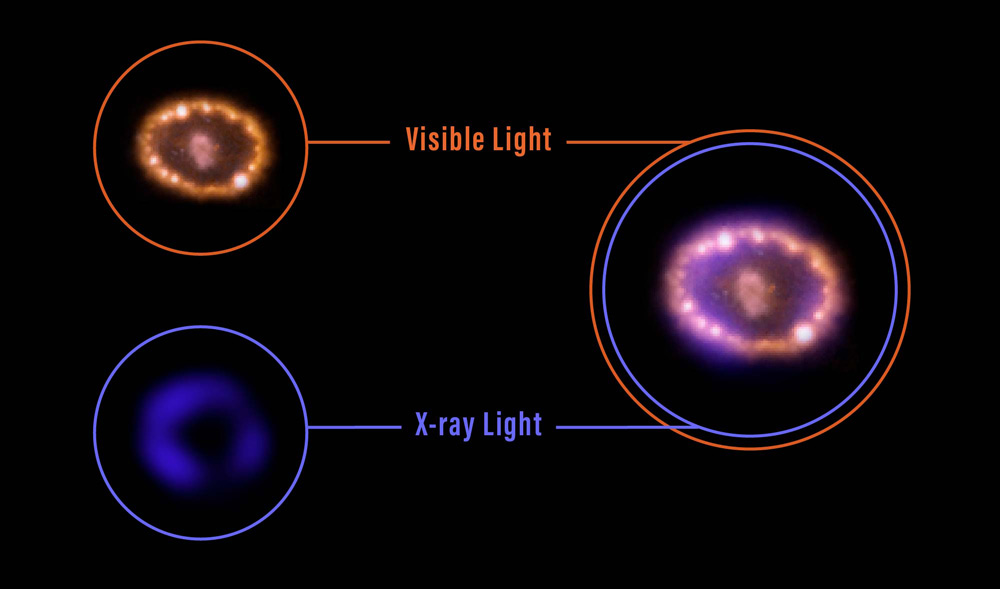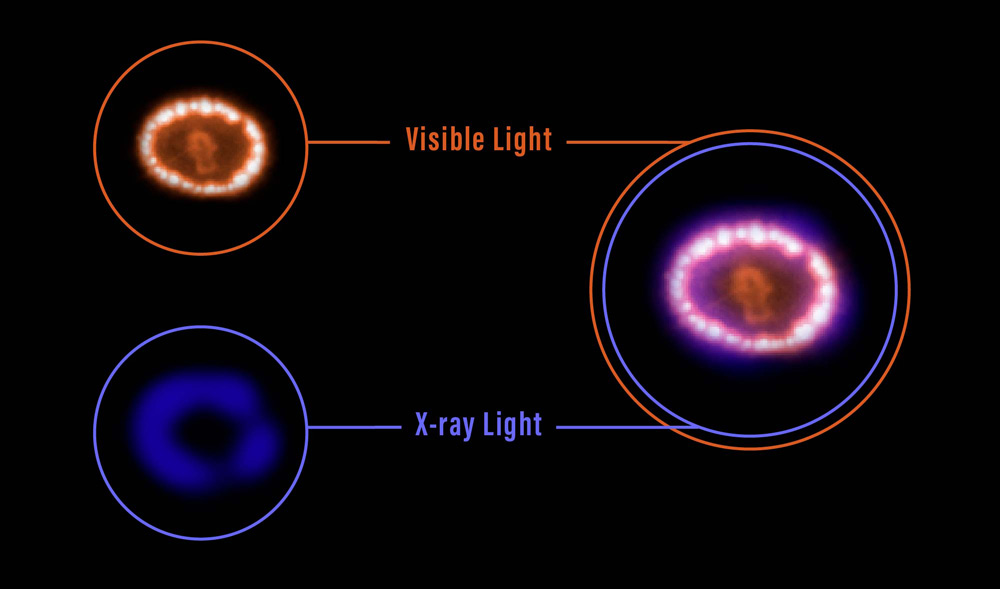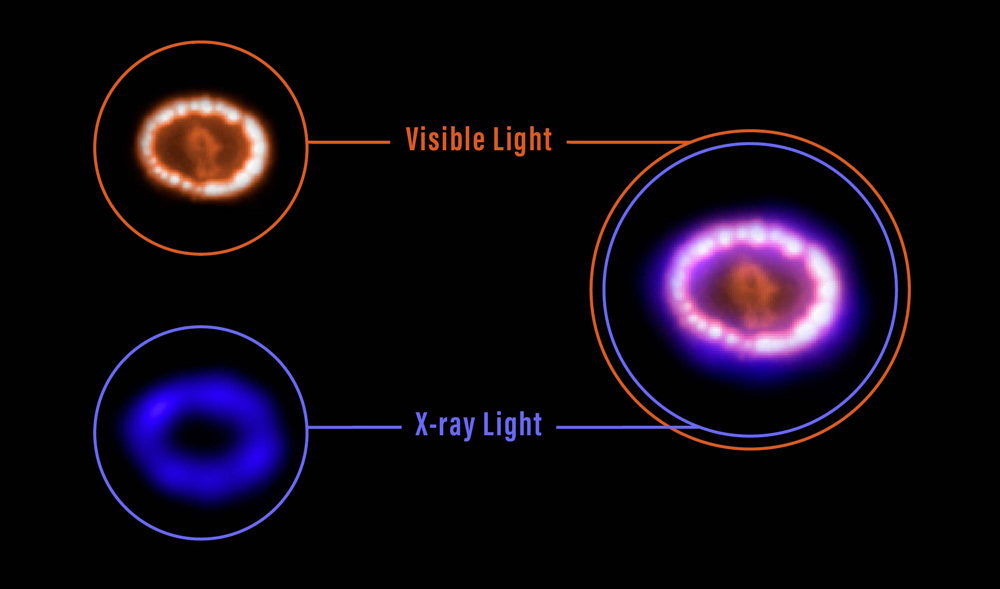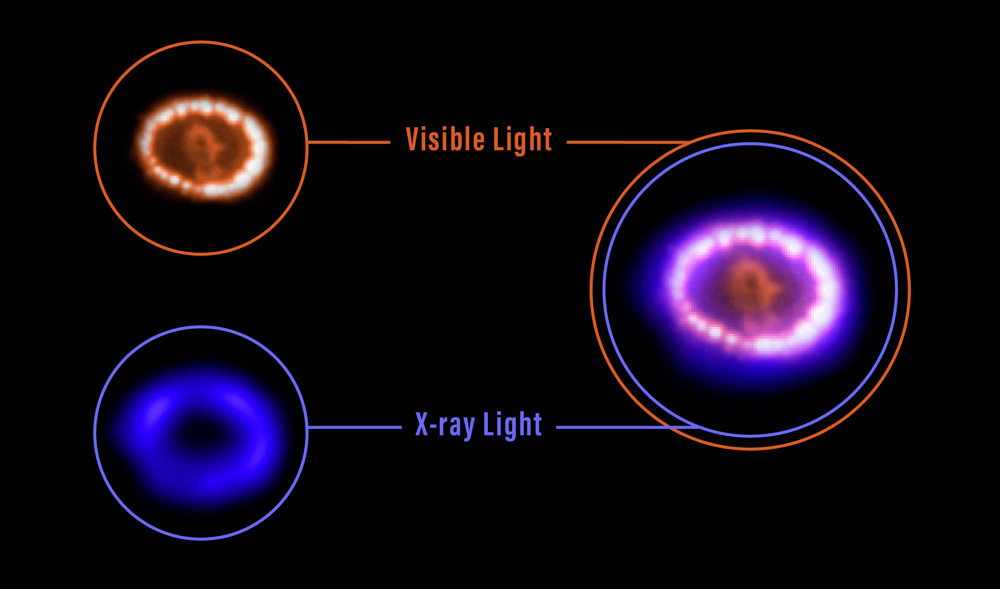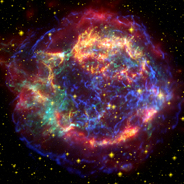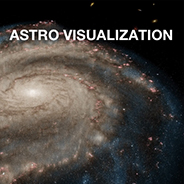Interactive Overview
Slider Interactive: A series of images showing visible and X-ray light from Supernova 1987A at four different times. Below the caption is a horizontal slider bar with four labeled stops and a solid white circle. Dragging the white circle right and left along the slider bar causes the image, labels, and caption to change. The change occurs gradually as one image, along with its associated captions and labels, fades out and the next fades in. A toggle button to the upper right of the image turns the image labels off and on. Labels are in the form of text with arrows pointing to specific features in the image.
Slider Stops
From left to right, the slider stops are labeled: 2000, 2005, 2009, and 2013.
Summary of Slider Stops
All four stops have the same layout. On the upper left is an image of the visible light from the supernova, circled in orange. On the bottom left is an image of the X-ray light from the supernova, circled in blue. On the right is a composite image showing both visible and X-ray light, circled in both orange and in blue. The two orange circles are connected by an orange line labeled “Visible Light.” The two blue circles are connected by a blue line labeled “X-ray Light.” The visible and X-ray images on the left show the same field of view at the same scale. The composite image on the right shows the same field of view, but at a slightly larger scale.
Sliding left to right reveals the following:
- “2000” stop shows a ring-shaped object. Visible light is in orange; X-ray light is in blue; and the combination of visible and X-ray looks pink and purple. This is the initial image shown when the interactive is loaded.
- “2005” stop shows the same object, but glowing brighter.
- “2009” stop shows material expanding and becoming even brighter.
- “2013” stop shows material continuing to expand and brighten.
Stop 1: 2000
Image Description: 2000
Visible-light image (top left) shows small, bright orange-white spots forming a clumpy ring around a dull, oval-shaped pinkish-orange splotch against a black background. The spots in the 11 o’clock and 5 o’clock positions are brighter and more distinct than others.
X-ray light image (bottom left) shows a hazy blue ring against a black background. The ring varies in thickness and brightness, with two very dim areas or gaps toward the 2 o’clock and 5 o’clock positions.
Composite image (right) shows small, bright pink-to-white spots forming a clumpy ring around a dull pinkish-orange splotch. The ring of points seems to have a thin blueish-purple halo.
Labels: 2000
There are three text labels. The bright white spot in the 5 o’clock position of the ring shown in the visible-light image on the upper left is labeled “Foreground star.” The hazy blue ring in the X-ray image on the bottom left is labeled “Hot, dense gas.” The pink to purple ring in the composite image on the right is labeled “Existing ring of gas and dust.”
Caption: 2000
A nearby supernova has allowed researchers to capture the events as they unfold on a very short time scale.
Stop 2: 2005
Image Description: 2005
Images of the supernova five years after the previous stop. In each image, the object appears similar in structure, size, and coloring to the previous stop, but brighter, with more distinct features.
Visible-light image (top left): The small orange-white spots are now brighter and more distinct, forming a ring that resembles a pearl necklace. Overall, the orange-white spots are much more even in brightness. The splotch in the center is larger and more orange in color, forming a distinctive keyhole shape.
X-ray light image (bottom left): The hazy blue ring is growing thicker and brighter. The two areas that look like gaps in the 2000 image appear to be filling in.
Composite image (right): The ring of bright spots is much brighter and more distinct. The blue halo surrounding the ring is more noticeable. The orange splotch is larger.
Labels: 2005
There are two text labels. The orange splotch in the center of the ring in the visible-light image on the upper left is labeled “Debris field.” The bright spots that make up the ring shown in the composite image on the right are labeled “Glowing knots of gas.”
Caption: 2005
A blast wave from the supernova explosion plows into previously ejected material from the central star, causing it to light up.
Stop 3: 2009
Image Description: 2009
Images of the supernova four years after the previous stop. In each image, the object appears similar in structure, size, and coloring to the previous stop, but brighter and slightly larger.
Visible-light image (top left): The orange-white spots forming the ring are even brighter and some now merge into each other. The keyhole-shaped splotch in the center is even larger – almost reaching the inner edge of the ring.
X-ray light image (bottom left): The hazy blue ring is even brighter and thicker, appearing less transparent than in the previous stops. The brightness and thickness vary, but the ring is now continuous, with no clear gaps.
Composite image (right): The ring of bright spots is much brighter and more distinct. The blue halo surrounding the ring is significantly brighter and wider. The orange splotch is larger, and now overlaps with the inner edge of the blue halo.
Labels: 2009
There are two text labels. A bright portion of the hazy blue ring in the X-ray image on the bottom left is labeled “Denser regions in ring.” The pinkish-orange splotch in the middle of the ring in the composite image on the right is labeled “Expanding debris field.”
Caption: 2009
As the blast wave passes through the expanding ring of gas, its knots become hotter and brighter.
Stop 4: 2013
Image Description: 2013
Images of the supernova four years after the previous stop. In each image, the object appears similar in structure, size, and coloring to the previous stop, but somewhat larger. Some parts appear brighter, but other parts are slightly dimmer.
Visible-light image (top left): Some of the orange-white spots forming the ring are brighter, but some toward the left are growing dimmer. The keyhole-shaped splotch in the center has grown larger, with part reaching into the ring.
X-ray light image (bottom left): The blue ring is significantly brighter and more opaque, and appears to have expanded outward. Its brightness and thickness vary slightly, but there are no gaps. The ring now resembles a slightly irregular donut.
Composite image (right): The blue halo now thickly outlines the entire ring of pink-white spots. The splotch in the center reaches through the inner part of the blue halo and into the bright portion of the ring.
Labels: 2013
There are three text labels. A relatively dim spot along the ring in the visible light image on the upper left is labeled “Cooling gas.” The bright blue ring in the X-ray image on the bottom left is labeled “Ring of gas and dust.” The outer edge of the bright blue halo around the pink-white ring in the composite image on the right is labeled “Blast wave exiting the dense ring.”
Caption: 2013
While the blast wave moves beyond the dense ring of gas, visible light emitted by the knots of heated gas will continue to fade.
